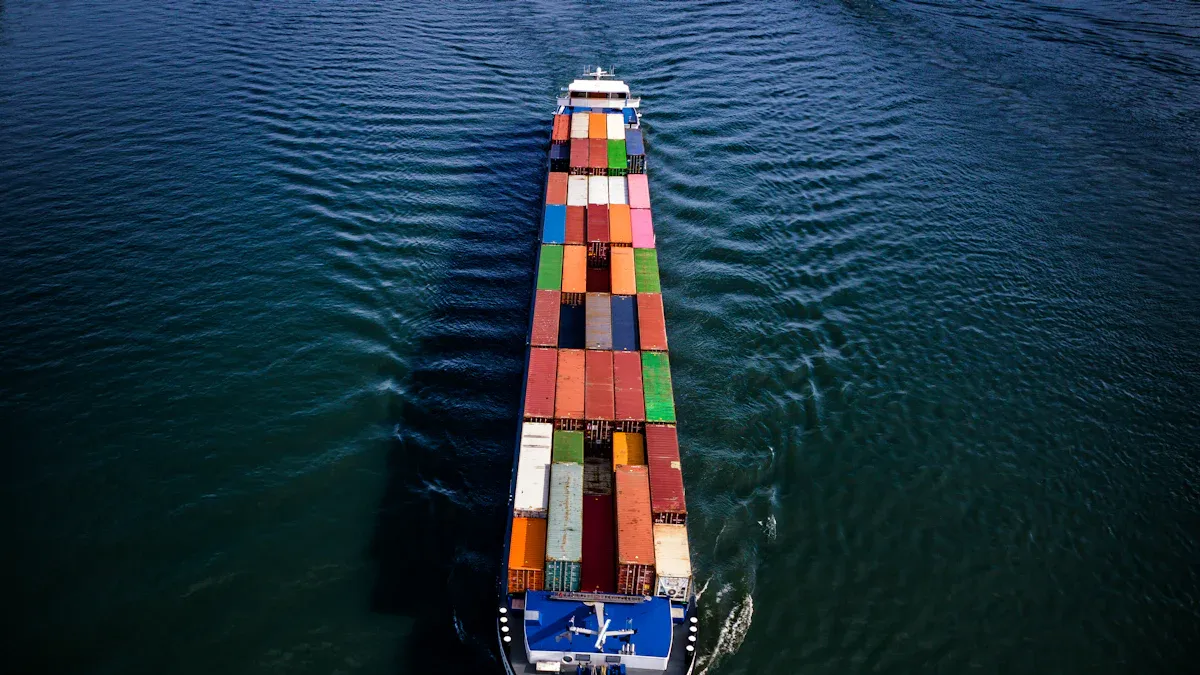Freight cost forecast and cost trends in air, sea, and rail to European markets

You see shipping costs change when sending goods to Europe. Sea freight rates from Shanghai to Rotterdam are now $7,961 per FEU. Rail freight costs about USD 3,240 per FEU in 2024. Air freight rates are about USD 2.54 per kg. This is a small drop from last year. Knowing these changes helps you plan better. Platforms like Fishgoo help with cross-border shipping and cost management. They give you good support as you look at the freight cost forecast.
Key Takeaways
Check shipping costs often. Air, sea, and rail prices can change fast. Use tools like Fishgoo's shipping calculator to keep track.
Know the good things about each shipping method. Air freight is quick but costs a lot. Sea freight is slower but cheaper for big loads.
Watch for changes in the market and problems. Things like port congestion or political issues can change costs and delivery times.
Use technology to save money. Digital platforms help you track shipments, compare prices, and manage logistics well.
Plan your shipments carefully. Combine orders and be flexible with shipping times to save more money.
Freight Cost Forecast Overview
Current Shipping Costs to Europe
You need to understand how shipping costs compare when sending goods to Europe. Each mode of transport offers different advantages. The table below helps you see the differences:
Cost Comparison | Speed Comparison | |
|---|---|---|
Air Freight | Most expensive | Fastest option |
Sea Freight | Cheapest for large shipments | Slowest option |
Rail Freight | Less than air freight | Quicker than sea freight |
Sea freight rates have stayed high or dropped only slightly as July ends. Many European ports face congestion, which causes delays and vessel cancellations. Air freight rates from China to Europe have dropped by 5.5% according to the TAC Index. Even with this drop, rates remain much higher than before the pandemic. For example, air cargo services from Hong Kong to Europe cost 38.4% more than last year.
You see that rail freight costs about USD 3,240 per FEU in 2024. Sea freight from Shanghai to Rotterdam is around $7,961 per FEU. Air freight rates average about USD 2.54 per kg. These numbers show that shipping costs can change quickly. You must watch these trends to plan your shipments well.
Tip: Use shipping calculators on platforms like Fishgoo to check the latest rates before you ship. This helps you avoid surprises and manage your budget.
Freight Cost Forecast for 2024-2025
You want to know what will happen to shipping costs in the next two years. The freight cost forecast for Europe shows a mixed picture. The European freight market will likely see no growth in 2024. In 2025, you can expect a small recovery with a growth rate of 1.1%. Over the next five years, the market could grow by up to 2% each year.
The freight cost forecast for air freight points to a possible increase of 5% to 15%. Geopolitical tensions and changes in demand drive this rise.
Sea freight rates will probably stay high. Even with new ships added, congestion and strong demand keep prices up.
Air cargo rates from China to Northern Europe have dropped by 1%, now at $3.68/kg. This shows that air freight costs can move up or down quickly.
Several factors shape the freight cost forecast for Europe:
Mode of transportation: Air, sea, and rail have different costs and speeds.
Shipment size and weight: Larger or heavier shipments cost more.
Distance to destination: Longer trips mean higher costs.
Delivery speed: Faster delivery raises the price.
Fuel price changes: When fuel costs go up, so do shipping costs.
Extra services: Insurance, packaging, and other add-ons increase the total.
Market supply and demand: Busy seasons or economic changes can push prices higher.
You can track these trends using key economic indicators. The table below lists some important ones:
Indicator Name | Description |
|---|---|
Freightos Baltic Index | Tracks container freight rates in USD for shipping containers. |
World Container Index (WCI) | Composite indicator of container freight rates for major lanes. |
China (Export) Containerized Freight Index (CCFI) | Measures container freight rates from major ports in China. |
Harpex | Shows weekly container shipping rate changes. |
Freightos Baltic Global Container Freight Index (FBX) | Spot rates across global trade lanes. |
You also see that road freight prices in Europe dropped in early 2025. The Upply spot road freight rate index fell by 3.8 points. The contract index lost 2.3 points. This means that some shipping costs may go down, but others may rise.
Note: Always check for the latest updates before making decisions. The freight cost forecast can change quickly due to world events or market shifts.
You can use this information to plan your shipments and manage your budget. By understanding the freight cost forecast, you stay ahead of changes in the European market.
Key Drivers of Freight Market Trends
Supply and Demand Shifts
Supply and demand affect freight costs a lot. When there are more ships than needed, ocean freight rates go down. In 2025, ocean freight prices are lower because many ships are available. Busy seasons make rates go up for a short time. If you ship during these times, you pay extra. Base shipping costs, fuel surcharges, and customs fees change with demand. Companies need to watch these things to control costs. Road freight rates in Europe show mixed results. Spot market prices dropped in Q2 2025 because demand was weak. Contract rates went up a little. These changes show supply and demand can quickly change the freight market.
More shipping capacity than demand makes ocean freight cheaper.
Busy seasons cause freight rates to go up for a short time.
Weak demand in road freight makes prices less certain.
Geopolitical and Regulatory Impacts
Geopolitical events can make shipping harder. The Russia-Ukraine conflict changed routes and raised sea freight costs. Risks like these can make shipping prices change fast. You also need to follow new rules in Europe. These rules add extra costs for following and reporting. The table below lists some new rules and how they affect shipping costs:
Regulation | Description | Impact on Shipping Costs |
|---|---|---|
Import Control System 2 (ICS2) | Needs a full Entry Summary Declaration for goods sent to the EU. | Raises costs for businesses to follow the rules. |
EU Emissions Trading System (ETS) | Adds shipping to ETS, so companies must buy emission allowances. | Makes shipping more expensive because of allowance costs. |
VAT and IOSS Adjustments | All goods sent to the EU need VAT, and U.S. sellers must register for IOSS. | Raises costs for online sellers because of VAT rules. |
Enhanced Air Freight Customs Regulations | Needs more data reporting for air freight forwarders and carriers. | Raises costs for following new reporting rules. |
Technology and Logistics Innovation
New technology helps manage freight better. Digital platforms let you look at shipment data and see cost trends. Predictive analytics help you plan for problems and save money. Autonomous trucks and smart tools use less fuel and deliver faster. Companies using Transportation Management Systems (TMS) save up to 15% on transportation. The table below shows how new ideas help save money:
Innovation Type | Impact on Cost Efficiency |
|---|---|
Digital Platforms for Freight Management | Cut operating costs by 10-15% |
IoT and Smart Logistics | Make supply chains clearer and help quick choices |
Artificial Intelligence and Data Analytics | Can make logistics work better by 15% |
Transportation Management Systems (TMS) | Can cut transportation costs by up to 15% |
Digital platforms make shipping across borders easier. They help small businesses trade worldwide and lower barriers. These tools also help teams work together, make faster choices, and avoid delays.
Tip: Use digital logistics platforms to track shipments and save money.
Air Freight Market Forecast
Air Shipping Costs Trends
You have seen many changes in the air freight market update over the past year. Air freight costs to Europe have shifted because of economic changes and world events. In early 2023, demand for air cargo dropped. Inflation made people buy less, so fewer goods moved by air. The second half of 2022 saw even less activity. The Russia-Ukraine crisis made things worse. Airlines paid more for fuel, and this pushed up shipping costs.
In 2024, the air freight market update shows that rates in Europe moved differently than in other places. In November 2024, global air cargo rates reached $2.76 per kilo. Europe saw a 10% jump in air freight rates that month. This rise happened even as global air freight prices went down. You need to watch these trends because they can change quickly.
Note: Air freight rates in Europe do not always follow global trends. You should check the latest air freight market update before planning your shipments.
Air Freight Cost Forecast Factors
You want to know what will shape the forecast for air freight costs to Europe in 2024 and 2025. Many things play a role. Geopolitical events, like the Russia-Ukraine conflict, change flight routes and give some airlines an edge. E-commerce keeps growing, especially in Asia-Pacific. More online orders mean more demand for air freight. Production delays at big aircraft makers, such as Boeing and Airbus, limit how many planes can carry cargo. This makes capacity tight and can raise shipping costs.
You also see other important factors:
Increased demand for air freight when sea shipping faces problems or ports get crowded.
E-commerce now makes up half of the air freight market, especially in new markets.
Fewer new planes mean less space for cargo, which can push up costs.
Fuel prices matter, too. When oil and jet fuel prices go up, air freight costs rise. After the pandemic, demand for air travel and shipping grew, but capacity stayed limited. This mix keeps shipping costs high.
Tip: Track fuel prices and capacity news to better predict changes in air freight costs.
Sea Freight Market Trends

Sea Shipping Costs Analysis
There are many changes in ocean freight for Europe in 2024. Prices on Asia-Europe routes have gone down a lot. Most shipping companies now charge less than USD 3,000 for a big container. Many carriers are losing money because the market is tough. Ocean freight rates in Asia go up and down often. Too many ships and better ports help keep prices steady, but there are still risks.
Ocean freight prices on Asia-Europe routes dropped a lot.
Now, rates are under USD 3,000 for a 40-foot container.
Many shipping companies are not making money.
Rates in Asia change often because of supply and demand.
Too many ships and better ports help keep prices steady, but problems can happen.
Carriers try to make prices higher, but it is hard to keep them up.
New services and moving ships change how much space is open.
Shipping costs from China to North Europe are 523% higher than last year. There are also big jumps for shipments to the US. These changes show that ocean freight prices can change very fast.
Sea Freight Cost Forecast Drivers
You need to watch some important things that affect ocean freight prices in Europe. Higher fuel prices make shipping more expensive. Fuel is now a big part of what carriers pay. Problems like the Ukraine conflict add more costs and risks. There are not enough drivers, and this could get worse. If it does, it will be harder to move goods and cost more for everyone.
Global trade numbers also matter a lot for ocean freight prices. The table below shows how different things affect shipping costs:
Factor | Description |
|---|---|
Demand | People in Europe buy less and keep smaller inventories. |
Disruptions | Cape rerouting uses up 8–10% of ships; Suez Canal reopening is not sure. |
Policy | EU rules like CBAM and global trade changes affect exports. |
Freight Rate Trends | Contract prices from Asia to Northern Europe are lower than before. |
Carrier Capacity Moves | MSC's new FAK prices for June 2025 show they manage space actively. |
Transatlantic Trends | Prices for both eastbound and westbound dropped in early May. |
You should watch these things. They help you see why ocean freight prices change and how to plan your shipping.
Rail Freight Market Forecast

Rail Shipping Costs Update
Rail shipping costs to Europe in 2024 have stayed steady. Ocean freight rates changed a lot, but rail prices did not. Here are some facts you should know:
Rail freight rates to Europe were $3,085 per FEU in January 2024.
By December 2024, rates went up to $3,215 per FEU.
This is a 4.2% increase for the year.
Rail freight costs did not rise as much as air or sea rates. For example, global average air cargo rates went up by 2% in July 2024 to $2.56 per kilo. That is a 14% increase from last year and a 47% jump from before the pandemic. Spot rates from Asia-Pacific to the U.S. rose by 5%, with prices over $6 per kilo. These numbers show rail is still a good choice for many shippers.
Note: Rail shipping gives you a good mix of speed and price. It is a strong option if you want reliable service and steady costs.
Rail Freight Cost Forecast Insights
You want to know what affects the rail freight market forecast. Many things shape the outlook for 2024 and 2025:
Digitalization of rail freight services
Competition from other freight options
Regulatory compliance and emissions reduction needs
Advances in logistics and intermodal transport
Use of predictive maintenance and digital tracking
Big infrastructure projects also change cost trends. The table below shows some important developments:
Project Name | Description | Expected Impact on Costs |
|---|---|---|
Brenner Base Tunnel | Lets longer, heavier trains cross the Alps. | Saves time and lowers costs. |
Rail Baltica | Connects Baltic States to Europe and improves intermodal choices. | Opens new routes and helps freight move better. |
ERTMS | Makes signaling the same for international rail traffic. | Boosts speed and capacity, cutting costs. |
EU Sustainable Mobility | Wants to grow rail freight’s share with policy and funding. | Makes rail more equal with road transport and may lower costs. |
You should keep an eye on these projects and trends. They help you get ready for changes in the freight market forecast and make smart shipping decisions.
Market Disruptions and Risk Factors
Port Congestion and Strikes
Freight costs can change a lot when European ports get crowded or have strikes. These problems slow down shipping and make planning harder for you. When Antwerp had a national strike on June 25, the yard was over 90% full. Hazardous cargo waited more than two days. Carriers charged 30% more for container demurrage fees because of long delays. Extra cargo from Antwerp went to Rotterdam and Hamburg. This made those ports even busier and caused more delays.
Here is a table showing recent impacts:
Port | Impact | Details |
|---|---|---|
Antwerp | Severe Congestion | National strike led to record congestion, yard use over 90%, delays 48+ hrs |
Antwerp | Carriers imposed 30% surcharge on demurrage fees | |
Rotterdam & Hamburg | System-wide Bottlenecks | Overflow from Antwerp caused strain and delays |
Average waiting times also went up:
Port | Average Waiting Time (hours) | Causes of Delays |
|---|---|---|
Rotterdam | 44-72 | Strikes, technical issues, overloads |
Antwerp | 44-80 | Strikes, high demand |
Hamburg | 40-60 | Congestion from alliance changes |
Tip: Fishgoo’s extra services, like insurance and strong packaging, help protect your goods during these problems.
Trade Policy and Customs Changes
Changes in trade rules can change what you pay for customs when shipping to Europe. For example, when the US added customs duties on EU products, American importers paid more. European shoppers did not see big price jumps. The EU did not add tariffs on American goods, so prices for those stayed the same in Europe. You may not pay higher customs costs, but fewer people in the US might buy European goods.
Other Disruptive Events
Other things can also mess up the freight market. Natural disasters, cyberattacks, or new rules can slow shipping or make it cost more. You need to watch out for these risks. Fishgoo helps you deal with these problems by offering package consolidation, shockproof packaging, and insurance. These choices give you more control and help you feel safer when shipping across borders.
Note: Always check for updates about port status and trade rules before you plan your next shipment.
Cost Management Strategies for Shippers
Reducing Shipping Costs
You can save money on shipping in many ways. Companies try different transportation modes to find good prices. Switching between air, sea, and rail helps you pick the cheapest way for each shipment. If you combine small orders into one big container, you often pay less. Being flexible with shipping times lets you get lower rates when it is not busy.
Some businesses use technology to spend less on shipping. One European retailer used AI to plan shipments and saved 33% on logistics costs. This saved them about €3.5 million every year. Another study found that adding a distribution center in Germany cut costs by 5-10%. It also made driving distance 35% shorter. These examples show that planning and using new tools can help you save a lot.
Tip: Try Fishgoo’s package consolidation and warehousing to combine orders and pay less for shipping.
Managing Freight Risks
Managing risks in shipping keeps your goods safe and helps you control costs. Always check for delays, strikes, or crowded ports before you ship. Adding insurance protects your parcels from loss or damage. Fishgoo offers shockproof and waterproof packaging to keep your items safe. These choices help you avoid extra costs if something goes wrong.
You can use shipping calculators to guess costs and plan for surprise fees. Watching for changes in customs rules or trade policies helps you avoid problems.
Leveraging Logistics Platforms
Logistics platforms like Fishgoo give you helpful tools for shipping. These platforms do many tasks automatically, so you save time and work. You can track shipments, compare prices, and talk to carriers right away. The table below shows some main benefits:
Benefit | Description |
|---|---|
Increased efficiency | Automates tasks and makes shipping faster. |
Transparency | Lets you watch shipments and work with carriers in one place. |
Cost reduction | Gives you more carrier choices for better prices and deals. |
You can also use coupons and extra services on Fishgoo to lower shipping costs. These features help you stay competitive and keep your business running well.
You have seen that freight costs for air, sea, and rail to Europe can change quickly. Watching market trends and disruptions helps you plan better. Use shipping calculators and value-added services to manage costs. Fishgoo gives you tools for efficient cross-border shipping. Stay alert to new rules and global events. If you follow these steps, you can ship smarter and keep your business strong in the changing European market.
FAQ
How can you check the latest shipping rates to Europe?
You can use Fishgoo’s shipping calculator. Type in where you want to send your package. Add your package details. The calculator shows the newest rates for air, sea, and rail.
What value-added services does Fishgoo offer for shipping?
Fishgoo gives you:
Package consolidation
Insurance
Shockproof and waterproof packaging
Reinforced outer boxes
These services keep your items safe and help you spend less on shipping.
How do you save money on international shipping?
You can put many orders together in one box. Pick slower shipping if you can wait. Use Fishgoo’s coupons and look for discounts before you pay.
What should you do if your shipment gets delayed?
First, use Fishgoo’s tracking tools to watch your parcel. If it is late, talk to customer support. You can also add insurance to feel safer.
See Also
Top Shipping Paths From China To Spain: Prices And Tips
Maximizing Your International E-Commerce Logistics For Success
Shopping Online From China: Best Platforms And Shipping Tips


